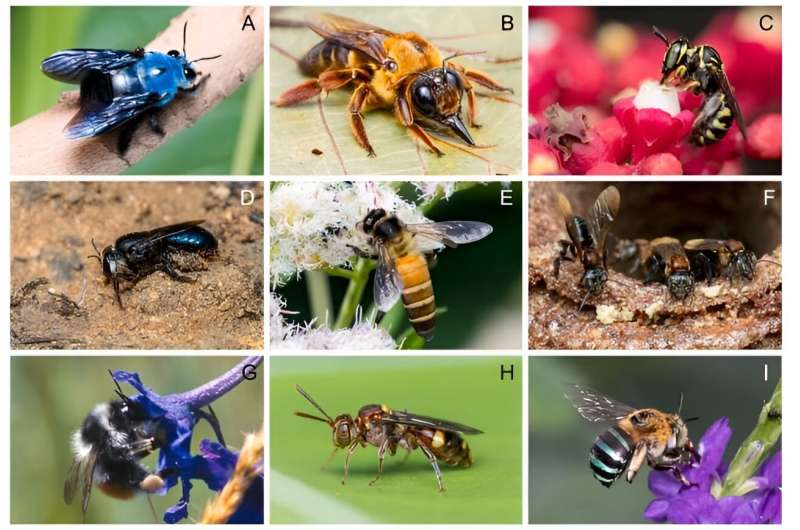This article has been reviewed according to Science X's editorial process and policies. Editors have highlighted the following attributes while ensuring the content's credibility:
fact-checked
peer-reviewed publication
trusted source
proofread
Warning sting on Asia's bee pollinators

Bee pollinators are a crucial link to food production and food security for more than have the world's population living in Asia—but few species have been closely studied or assessed for their range, numbers and conservation status.
The warning comes as 74 scientists working in 13 Asian and other countries warn that the region's bees—which comprise 15% of the world's known bee species but only 1% of records—could be under threat due to major habitat loss to urbanization, pollutants, alien species, climate change and other human forces.
"While most studies of bees take place in high-income countries, they have all raised concerns and calls for more conservation or management solutions to curb or stop declines of bees and other pollinators," says entomologist Dr. Michael Orr, from Germany's Staatliches Museum für Naturkunde Stuttgart, a lead author in a new article published in Biological Conservation.
"Given the key roles native bees play, both ecologically and economically in a region like Asia, understanding how to manage and maintain bee diversity is crucial to sustainable development in the region," says Dr. Orr, who also is a member of the International Union for Conserving Nature (IUCN) Wild Bee Specialist Group (Asia) as well as Beijing and America ecological societies.
"The biggest impediment is a lack of knowledge about where and how species live, and foundationally an inability to even identify different species."
In the meantime, the authors call for attention flagship social species such as native honey bees, stingless bees and bumble bees to start the important conservation work. Flagship species can be essential for conservation messaging and to support broader conservation of the other 85%–90% of non-social bees, the experts say.
Solitary flagship bees are also important, including the world's largest bee, the Indonesian Megachile pluto, which is frequently sold online to western buyers for exorbitant sums despite being listed as Vulnerable by the IUCN.
The authors call for trans-border partnerships to work on bee and other pollinator management, given the complex political dynamics of the region. As well, active restoration of more intact or threatened habitat should be prioritized, given "dire threats" such as land conservation to palm oil and widescale agricultural expansion.
"Science and research collaborations can help mend some of these divisions, but more open sharing of specimens and data will be key," adds Flinders University co-author, Dr. James Dorey.
"Ecological studies at the national and regional level must be conducted to better understand how best we can maintain pollinator communities and the ecosystem services they provide."
To reach their maximum potential, the scientists say conservation efforts must also be multi-disciplinary and cross-sectoral, bridging fields and methods as well as governmental, NGO and research personnel to better translate research into practical applications and effective conservation management for bees across Asia.
More information: Natapot Warrit et al, Opportunities and challenges in Asian bee research and conservation, Biological Conservation (2023). DOI: 10.1016/j.biocon.2023.110173
Journal information: Biological Conservation
Provided by Flinders University




















